
860–880 Lake Shore Drive is a twin pair of glass-and-steel apartment towers on N. Lake Shore Drive along Lake Michigan in the Streeterville neighborhood of Chicago, Illinois. Construction began in 1949 and the project was completed in 1951. The towers were added to the National Register of Historic Places on August 28, 1980, and were designated as Chicago Landmarks on June 10, 1996. The 26-floor, 254-ft tall towers were designed by the architect Ludwig Mies van der Rohe, and dubbed the "Glass House" apartments. Construction was by the Chicago real estate developer Herbert Greenwald, and the Sumner S. Sollitt Company. The design principles, first expressed in the 1921 Friedrichstrasse Skyscraper competition in Berlin and built thirty years later in 860–880 Lake Shore Drive, were copied extensively and are now considered characteristic of the modern International Style as well as essential for the development of modern High-tech architecture.
This is a list of the 129 National Register of Historic Places listings in Cook County, Illinois outside Chicago and Evanston. Separate lists are provided for the 62 listed properties and historic districts in Evanston and the more than 350 listed properties and districts in Chicago. The Chicago Sanitary and Ship Canal Historic District extends through the West Side of Chicago, DuPage County and Will County to Lockport.

Central House is an 1860s hotel building located in the 800-person village of Orangeville, in Stephenson County, Illinois, United States. The building was built by Orangeville founder John Bower and operated as a hotel from its construction until the 1930s, when it was converted for use as a single family residence. The three-story building was the first commercial brick structure in downtown Orangeville. Architecturally, the building is cast in a mid-19th-century Italianate style. Central House was added to the U.S. National Register of Historic Places in 1999.
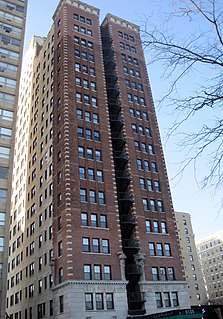
The Flamingo-on-the-Lake Apartments, also known as the Flamingo Apartment Hotel, is a building designed by architect William C. Reichert and located at 5500-5520 S. Shore Drive along Lake Michigan in the Hyde Park neighborhood of Chicago, Illinois. The 16-story apartment building was built with 144 apartments and 16 hotel rooms in 1927; it also featured an outdoor pool and bathhouse. It was designed in the Classical Revival style; its exterior is red brick with terra cotta ornamentation and a dentillated cornice. It and the adjacent building, The Promontory Apartments, a co-op building designed by Mies van der Rohe, are the furthest east buildings in Hyde Park.

The Plano Hotel is a 19th-century hotel building located in Plano, Illinois, United States. It was built in 1868 by John K. Smith and reflects the Italianate architectural style. In 1993, the building was added to the U.S. National Register of Historic Places.

The Milner Arms Apartments, originally known as the Hotel Stevenson, is a high rise building located at 40 Davenport Street in Midtown Detroit, Michigan; it was listed on the National Register of Historic Places in 1997. It is adjacent to, but not part of, the Cass-Davenport Historic District.

The Whittier is a partially renovated high rise residential complex and former hotel located at 415 Burns Drive in Detroit, Michigan, on the Detroit River. It was listed on the National Register of Historic Places in 1985.
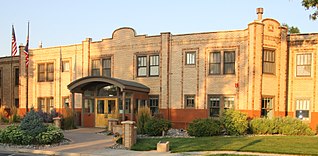
The Callaghan Apartments, also known as the Plaza Apartments and Hotel and the Plaza Hotel, was erected in 1918 in Hot Springs State Park in Thermopolis, Wyoming. It was at one time one of six hotels catering to tourists using the Big Spring of Thermopolis, a hot spring reputed to possess curative properties. The hotel was erected by bricklayer James Callaghan, who obtained a 98-year lease on the site commencing on January 1, 1918. Callaghan made his own bricks in a kiln he built on the site, completing the Callaghan Apartments in June 1918. He employed several nurses and a masseur for his guests. In 1921 Callaghan sold the property to Dr. P.W. Metz who renamed it The Plaza.

The Hotel Aurora, also known as Aurora Hotel, is a hotel built in 1917 on Stolp Island in Aurora, Illinois.
Currently there are 124 properties listed on the National Register of Historic Places in Central Chicago, out of more than 350 listings in the City of Chicago. Central Chicago includes 3 of the 77 well-defined community areas of Chicago: the historic business and cultural center of Chicago known as the Loop, as well as the Near North Side and the Near South Side. The combined area is bounded by Lake Michigan on the east, the Chicago River on the west, North Avenue on the north, and 26th Street on the south. This area runs five and one-quarter miles from north to south and about one and one-half miles from east to west.

The Burtis–Kimball House Hotel and the Burtis Opera House were located in downtown Davenport, Iowa, United States. The hotel was listed on the National Register of Historic Places in 1979. It has since been torn down and it was delisted from the National Register in 2008. The theatre building has been significantly altered since a fire in the 1920s. Both, however, remain important to the history of the city of Davenport.
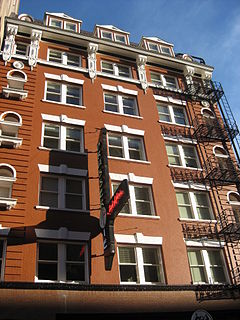
The Calumet Hotel, also known as the Esquire Hotel, is a former hotel building located in downtown Portland, Oregon, that is listed on the National Register of Historic Places. The building was changed from a commercial hotel to a residential hotel for low-income residents in the 1930s. At some point, it took the name Esquire Hotel. By the time of its nomination to the National Register, in 1983, it was vacant. The building was renovated in 2008–09 and is now known as "The Esquire" apartments.

The Campbell Hotel, located in northwest Portland, Oregon, is a historic former residential hotel that is listed on the National Register of Historic Places (NRHP). It is now an apartment building named the Campbell Court Apartments.
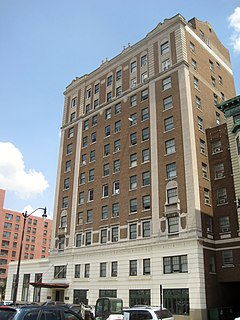
The St. Nicholas Hotel is a historic hotel building located at 400 E. Jefferson St. in Springfield, Illinois, US.

Hotel St. Benedict Flats is a historic apartment building located at the northeast corner of Chicago Avenue and Wabash Avenue in the Near North Side neighborhood of Chicago, Illinois. Built in 1882, the building was one of the "French flat" luxury apartments constructed after the Great Chicago Fire; named for their resemblance to Parisian apartments, these new buildings brought apartment living to Chicago's upper class. The building was built by Loyola University with the intention to use the revenue to pay for healthcare for the poor. Architect James J. Egan, an Irish Catholic better known for his church designs, designed the Victorian Gothic building. The building's decorative features, such as its lintels, art glass windows, and use of pressed metal, were common features of contemporary upper-class homes, while its mansard roofs evoked French architecture. Egan named the building for the property's previous owners, the Order of Saint Benedict; the "Hotel" portion of the name was added to exploit a legal loophole, as the building never served as a hotel. The original doors still remain on the flats.

The Hotel Del Prado is a historic apartment hotel at 5307 S. Hyde Park Boulevard in the Hyde Park neighborhood in Chicago, Illinois. Built in 1918, it is the oldest of the several apartment hotels built in Hyde Park in the late 1910s and 1920s. Hyde Park was growing in both population and prestige at the time, creating a need for additional housing. Apartment hotels were a fashionable choice, as they combined the amenities and prestige of hotels with the affordability of apartments. The Hotel Del Prado had 198 apartments and included commercial space on its first and second floors. Its Neoclassical design includes Palladian windows on its lower floors, terra cotta trim throughout its exterior, and carved American Indian heads atop terra cotta columns.
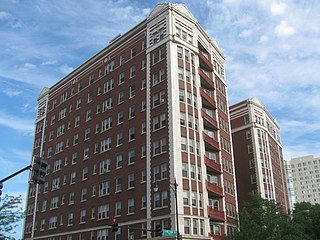
The East Park Towers are a historic apartment building at 5236-5252 S. Hyde Park Boulevard in the Hyde Park neighborhood of Chicago, Illinois. The building was constructed in 1922-23 during a period of residential growth in Hyde Park. While it had no guest rooms, the apartments offered similar amenities to an apartment hotel, such as housekeeping service. Apartment hotels were popular as part-time housing for wealthy workers, as they combined the amenities of in-home service with the affordability of apartments, and the East Park Towers were one of several such apartments built in Hyde Park at the time. Architect William P. Doerr designed the building in the Georgian Revival style; his design included terra cotta belt courses and quoins and Palladian windows on the first floor.

The Mayfair Apartments are a historic apartment hotel at 1650–1666 E. 56th Street in the Hyde Park neighborhood of Chicago. Built in 1926, the building was part of a wave of residential department in Hyde Park, and it was one of several apartment hotels constructed there in the late 1910s and 1920s. Apartment hotels were popular among wealthy workers looking for part-time city housing, as they combined the amenities and prestige of a hotel with the price and location of apartments. The architecture firm Lowenberg & Lowenberg designed the building in the Georgian Revival style. The building's first three stories are clad with limestone and decorated with flat Corinthian columns and balustrades on the second-story windows. The remainder of the building is brick and includes a dentillated cornice at its roof and a second cornice above its eleventh story.
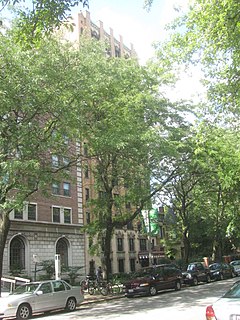
The Poinsettia Apartments are an apartment hotel at 5528 S. Hyde Park Boulevard in the Hyde Park neighborhood of Chicago, Illinois. Built in 1929, the building was the last of several apartment hotels built in Hyde Park during a period of residential development in the late 1910s and 1920s. Apartment hotels were popular among wealthier workers in the city at the time, as they combined the amenities and prestige of hotels with the affordability of apartments. The Poinsettia Apartments were both the smallest of the Hyde Park apartment hotels and the only building designed in the Spanish Colonial Revival style. Its design features pilasters spanning the height of the building, terra cotta ornamentation, and decorative window surrounds on the first two floors.


















